A type of self-starting single-phase induction motor which has copper rings shading the field poles is known as a shaded pole induction motor. The shaded pole induction motor is a type of split-phase type single-phase induction motor.
The shading rings (or copper rings) are used to make the motor self-starting. The shaded pole induction motor can only rotate in one particular direction. The rotation of the motor in the reverse direction is not possible.
It is very simple in construction, maintenance-free, and inexpensive, hence it is widely used in a variety of small power applications like relays, fans, exhaust fans, small water pumps, hot air blowers, etc.
The shaded pole motor is very popular for power ratings below 40 Watts.
Why is the Shaded Pole Induction Motor suitable for low power rating?
The following bottlenecks of this motor make it unsuitable for a higher power rating.
- The power Factor of the motor is very low, it draws a large magnetizing current. Thus, the no-load losses of the motor are quite high.
- The starting torque of the motor is very low.
- The efficiency of the motor is very low because of higher losses.
All the above constraints do not permit a design of a shaded pole induction motor of higher power rating. Therefore, they are designed for low power ratings.
Construction of Shaded Pole Induction Motor
Just like every induction motor, the shaded pole induction motor also has two parts namely the stator and rotor. The shaded pole motor can be designed in two or four poles. The speed of the motor is inversely proportional to the number of poles, and thus the speed of the 4 poles motor is just double the speed of the two poles motor. The connection diagram of a typical 4-pole shaded pole induction motor is shown in the below figure.
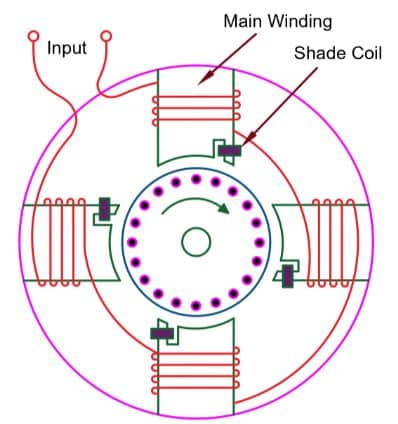
For simplicity, we consider only two poles in the motor. The connection diagram of a typical 2-pole shaded pole induction motor is shown in the below figure.
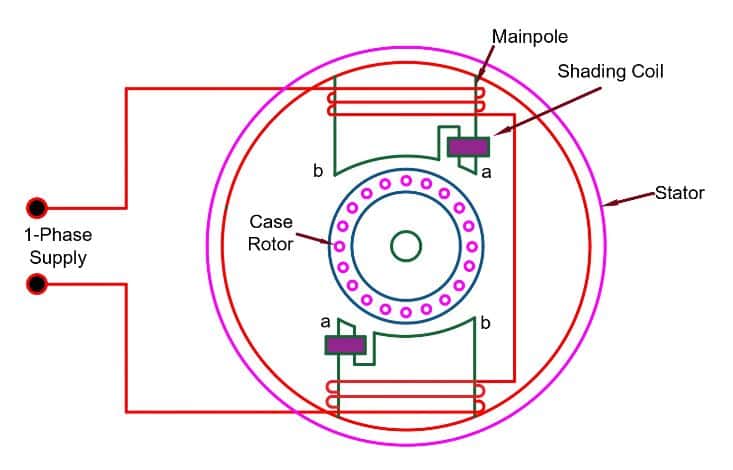
Stator:
As the name implies, a stator is the stationary part of the motor which carries the main field winding of the motor. The stator of the motor consists of salient poles that project towards the armature. Each of the poles contains an exciting winding. The poles are laminated to reduce the eddy current loss. Lamination is the process of the use of multiple layers of material for making the poles. The pole strength also improves with the lamination of the poles.
This type of motor is generally designed in two and four poles. A higher number of poles design is possible, but intricate the design of the motor.
The poles of the motor are divided into two unequal parts, where, the smaller part is shaded with a copper ring, hence called the shaded part of the pole. The copper ring is called a shading coil.
Rotor:
The rotor of the motor is of squirrel cage type rotor. In this motor, the rotor conductors are skewed by 60° in order to reduce the magnetic locking and increase starting torque. Also, the rotor conductors are skewed in V type, so that they can produce a better starting torque. The V-type skewing further reduces the magnetic locking between the stator and rotor.
The motor does not have commutator, brushes, or collector rings which makes the design of the motor complex. It also does not have a centrifugal switch. Thus, the motor has a fewer number of parts and it enhances the reliability of the motor. All these features enhance the reliability of the motor.
Copper Band
The copper band is used to shade some portion of the pole to produce the rotating magnetic field. About 1/3 rd portion of the pole is surrounded by a low resistance copper band. The other name of the copper band is shade band or shaded coil. After shading a pole with a copper band, both ends of the copper coil are shorted to form a closed circuit. The copper band just acts like a short-circuited transformer secondary winding. Every pole has a separate copper band.
Working of Shaded Pole Induction Motor
The working of a shaded pole induction motor is quite simple. When a single-phase AC supply is given to its stator winding, it produces the stator magnetic field. This magnetic field links to the shading rings. As a result, an EMF is induced in the shading rings.
The shading rings are made of high conductivity material copper and they form a closed loop. The current starts circulating in the shading ring because of induced EMF in it. This circulating current also produces a magnetic field that opposes the main magnetic field. Thus, there exists a space displacement in the shaded portion and unshaded portion of the motor. The space displacement between the main field and the shaded field is at an angle of 90°.
The motor produces a rotating magnetic field because of the time and space displacement between the main field and the shaded portion field. The rotating magnetic field rotates from the unshaded portion to the shaded portion of the motor. Consequently, this rotating magnetic field develops the starting torque in the motor.
How does the Rotating Magnetic Field Produce in Shaded Pole Induction Motor?
Let us understand the mechanism of rotating field production in a shaded pole induction motor.
The AC voltage is fed to the stator of the motor. The AC is sinusoidal and it has a different rate of voltage rise in its complete waveform. We divide the first half cycle of the AC waveform into three regions that have different rates of voltage rise, as shown in the below figure.

Region-1
In region-1, the rate of change of voltage is more therefore the rate of change of flux is more. The more rate of change of flux causes an increased induced EMF in a shading coil. The increased EMF in a shedding coil cause more circulating current and hence it produces more flux that opposes the main flux.
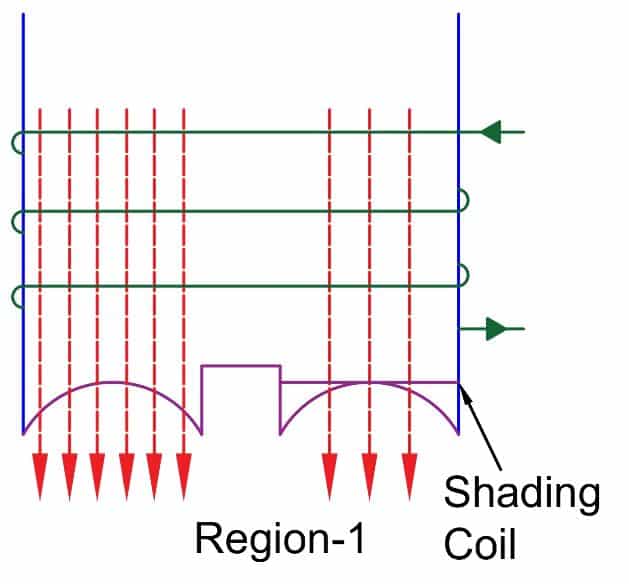
Thus, in this region, the flux in the shaded area is less than in the unshaded area. The maximum portion of the main flux will pass through the unshaded area and the resultant flux concentrates in the shaded area of the pole.
Region-2
In region-2, the rate of change of voltage is almost constant therefore there is a negligible rate of change in flux. The voltage induced in the shedding coil is zero when there is no rate of change of flux. There is no opposing flux to the main flux in region-2.
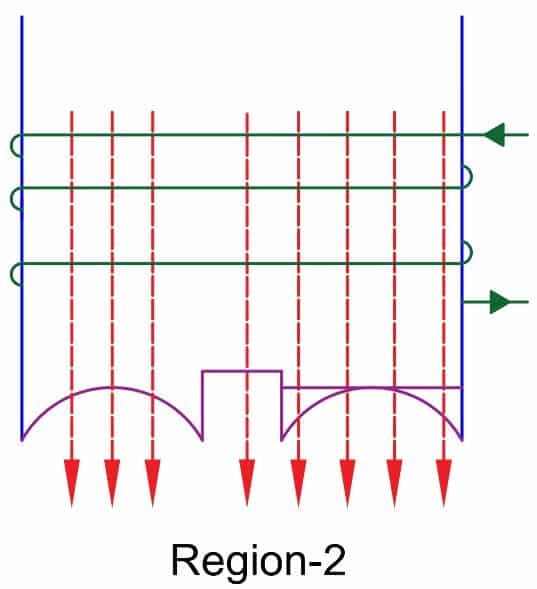
Therefore, the main flux is equally distributed in the shaded and unshaded areas. The position of the net magnetic field shifts from the left side of the unshaded area to the center of the pole.
Region-3
In region-3. the rate of change of flux is decreasing, therefore the induced EMF in the shedding coil decreases. The decreased EMF in the shedding coil causes decreased opposing flux. Thus, the main flux concentrates in the shaded region. Thus, the net magnetic field moves towards the shaded area of the pole.
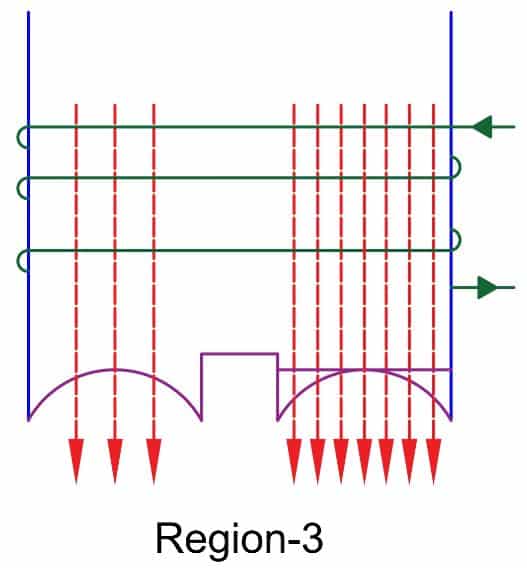
From the above, it is clear that the net magnetic field moves from the unshaded area to the shaded area in a positive half cycle of the AC waveform. In the next negative half cycle, the magnetic field moves from the shaded area to the center of the poles to the unshaded area. Thus magnetic field completes a rotation in a complete AC cycle. Thus, a rotating magnetic field is produced in the shaded pole induction motor.
The direction of rotation of the magnetic field can not be reversed in a shaded pole induction motor, therefore the shaded pole induction motor is unidirectional.
Advantages of Shaded Pole Induction Motor
The following are some main advantages of the shaded pole induction motors:
- Shaded pole induction motors have a quite simple construction.
- The starting current of the shaded pole motor is less.
- They require very less maintenance.
- Shaded pole motors have self-starting torque.
- Their life span is long.
Disadvantages of Shaded Pole Induction Motor
The key disadvantages of shaded pole induction motors are listed as follows:
- The most significant disadvantage of shaded pole motors is that they have very low starting torque.
- No reversing of rotation is possible in the case of a shaded pole induction motor.
- At the start, they have a very poor power factor.
- The efficiency of the motor is very low.
Applications of Shaded Pole Induction Motor
The shaded pole induction motors are widely used in low power ratings usually less than 40- Watt applications. Some common uses of shaded pole motors are listed below:
- Shaded pole induction motors are used in applications where low starting torque is required like drive devices.
- These are used in small devices such as exhaust fans, table fans, hairdryers, etc.
- This type of motor is also used for starting an electronic clock.
- These are also used in refrigerators and air conditioners for driving cooling mechanisms.